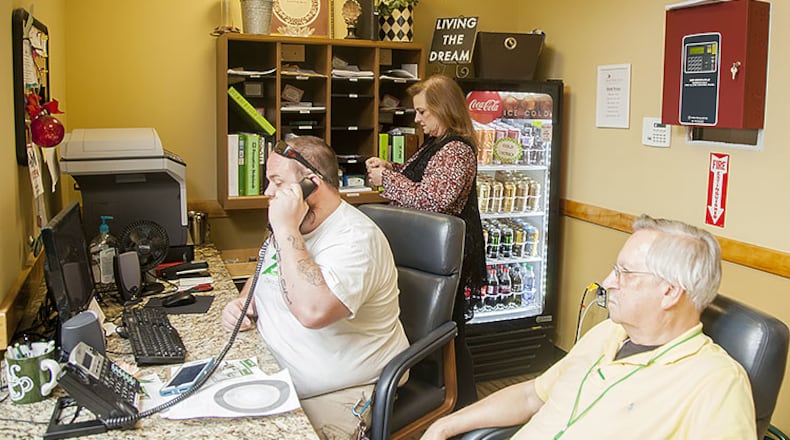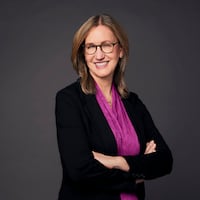Missy Owen lost a son to an overdose, so she doesn’t take it lightly when doctors push her other children to take opioid pain pills.
It happened when Owen’s daughter, in her 20s, and a teen son had their wisdom teeth removed. The kids were just as adamant as their mother about pain pills. They wanted no opioids after seeing what an addiction did to their brother. But it wasn’t easy to say no.
"They were almost begged to take that prescription," said Owen. "One of them, when she would not take it from the nurse, the doctor came back in and said, 'You really need to take this.'"
The daughter stood her ground and had an easy recovery using Advil and Tylenol.
Owen — a mother of five, including Davis, who died in 2014 — sees the dangers of opioids every day. She heads a recovery center in Marietta, called The Zone, where many visitors became addicted after an opioid prescription.
“It’s been frustrating because doctors, by and large, have not even changed their prescribing habits,” Owen said.
Starting July 1, writing a prescription for opioid pain medications will require an extra step in Georgia — a step that lawmakers hope may push health care professionals to make better prescribing decisions.
A state law, passed last year, mandates that doctors, dentists and other prescribers check a database to determine what prescriptions patients have recently filled before doling out certain drugs, including opioid painkillers and benzodiazepines such as Xanax.
The checks will be frequent. The total number of opioid prescriptions in Georgia topped 8 million in 2017, according to the Georgia Department of Public Health.
The confidential database, first authorized in 2011 but underused, will help medical professionals make sure that patients aren’t getting pain pills from multiple doctors. Prescribers also can better check that a patient is not taking a combination of drugs that could be dangerous. Taking opioids and benzodiazepines at the same time, for example, is risky.
Armed with a subpoena or search warrant, law enforcement can also use the database to investigate doctors accused of writing illegitimate prescriptions.
Overdose deaths across the nation have never been higher, and experts believe the database is part of the solution.
“We know that many people who develop an opioid addiction start with prescription opioids and often transition, eventually, to illicit drugs,” said Laura Edison, a medical epidemiologist at the Georgia Department of Public Health.
That’s why many experts continue to focus on legal opioid prescribing even when overdoses are increasingly linked to illegal drugs such as heroin.
“We have to stop the pipeline,” Edison said.
Numbers “still too high”
In Georgia, doctors are writing fewer prescriptions for opioids, but it’s hardly unusual.
Last year alone, 21.1 percent of Georgians filled at least one prescription for an opioid medication, according to new data from the Department of Public Health. That’s down from 22.6 percent from the year before.
Total opioid prescriptions dropped by about 6.8 percent from 2016 and 2017. But in a state with just more than 10 million people, 8 million opioid prescriptions means these medications are still coming into almost every family’s medicine cabinets.
"Those numbers are still too high, in my opinion," said Georgia Attorney General Chris Carr, who created a task force to deal with Georgia's opioid problem.
Carr said the new requirement to check the prescription-tracking database will help. "Timely and accurate data about the number of prescriptions that Georgians are receiving can only help all of us further fight this epidemic," he said.
The Department of Public Health’s study of the prescription-tracking database raises some potential red flags.
For example, the Centers for Disease Control and Prevention cautions against prescribing of high-dose opioids because of an increased risk of overdose.
But in Georgia, nearly 8 percent of patients receiving opioid prescriptions in 2017 — about 134,000 individuals— had prescriptions that crossed the high-dose threshold.
Also, it’s widely known that taking an opioid painkiller while also taking a benzodiazepine such as Xanax can put a patient at risk of overdose. But in Georgia, patients taking opioids were also prescribed benzodiazepines about 14 percent of the time. Patients also frequently had prescriptions for opioids that overlapped, the analysis found.
These findings raise questions about whether some Georgia doctors have gotten the message about changes in prescribing that the CDC says are needed.
The new requirement to check the database could help, since doctors will no longer rely solely on what patients tell them. If a patient is getting Xanax or pain pills from another prescriber, the database check will reveal those prescriptions.
Multiple opioid prescriptions from different doctors could indicate drug-seeking behavior.
The public health study isolated cases where patients obtained opioids from five or more prescribers and also filled prescriptions at five or more pharmacies over a six-month span. The good news: Cases fitting this definition were cut in half between the beginning of 2016 and the end of 2017. Even so, there were 4,233 instances in 2017 that fit this pattern. The database will flag these patients to help doctors identify a patient who may be taking a dangerous number of pills.
Treating pain without opioids
For some patients, the decline in opioid prescribing isn’t welcomed news. Patients complain it’s becoming harder and harder to get prescriptions that they need to deal with chronic pain. Even patients who want to get off opioids can find it difficult to do so because of a physical dependence that develops over time.
The WellStar Health System, which has hospitals and physician offices across metro Atlanta, said it has seen an increase in patients concerned about whether they will be able to keep getting the medications they have been on. The health system is trying to respond to the crisis by developing non-opioid treatments for pain.
But WellStar is also trying to cut down on the number of patients who are exposed to an opioid medication in the first place. ER doctors, for example, might put a patient on alternating doses of Motrin and Tylenol instead of a Percocet, which is an opioid, said Dr. John Brennan, the system’s chief clinical integration officer.
Even some patients undergoing operations are being moved away from opioids. Brennan said WellStar surgeons doing joint replacements, for example, can use an injected pain blocker, similar to novocain used in dental procedures, that will shield patients from pain during the critical post-op period.
Brennan said the patients are avoiding pain along with the side effects of opioids. Without the dullness of opioids, patients can get up and start moving earlier, allowing them to get home sooner and recover faster. Plus, the exposure to opioids, and the accompanying risk of addiction, is avoided. “It’s a win, win, win,” Brennan said.
Understanding the risks
When the opioid epidemic emerged as a public health threat, law enforcement agencies focused on pill mills that prescribed opioids for no legitimate medical purpose. Earlier this month, two Georgia physicians — William Bacon, 82, and Donatus O. Mbanefo, 64 — were found guilty for their role in prescribing medications at pill mills in Valdosta and Columbus. Bacon alone wrote prescriptions for more than 1.8 million Oxycodone pills in 27 months.
With new laws and high-profile arrests, blatant pill mills are less common.
Health officials now focus on well-meaning doctors who haven’t changed their prescribing habits in spite of revelations that opioids are extremely dangerous and may not even be the most effective choice for treating pain. Georgia’s medical board is requiring the state’s doctors to take a course on opioids to make sure physicians understand the latest information about the risks.
Owen, who founded the Cobb County recovery center after her son's overdose, said her work exposed her to a key study showing that over-the-counter pain medications can be more effective, and clearly safer, than taking an opioid. When two of her teens had their tonsils removed, Owen said, the doctor worked with her so that the kids could use ibuprofen and acetaminophen to control pain. That doctor understood. She wants more doctors to avoid prescribing opioids whenever possible.
People who come to The Zone, she said, were often first exposed to opioids after a sports injury, a skate-boarding accident or a dental procedure. She believes the new requirement to check the prescription-tracking database will help, although she says Georgia allows too many exemptions. She thinks the training for physicians will be critical.
"If they truly understand what is happening," Owen said, "and they understand the epidemic and how people are taking the medications that they give — maybe taking two or three pills and the rest end up on the street — I think they're going to think twice about their prescribing habits."
Georgia’s Prescription Drug Monitoring Program: How it works
Pharmacists are required to enter information about prescriptions into the confidential database. This requirement covers controlled substances categorized as Schedule II, III, IV and V. Georgia’s health care providers who can prescribe medications were required to register to use the PDMP by January 1 and must follow the requirements for checking the database starting July 1.
A prescriber is required to check the PDMP before writing a patient’s first prescription for a benzodiazepines or Schedule II opiate drug or cocaine derivative. If the prescription is continued, the prescriber must check the patient’s PDMP profile at least every 90 days.
Prescribers do not have to check the patient’s PDMP if:
- The prescription is for no more than a three-day supply and no more than 26 pills
- The patient is in a hospital, nursing home, hospice or intermediate care home.
- The patient has had outpatient surgery at a hospital or ambulatory surgical center and the prescription is for no more than a 10-day supply and no more than 40 pills.
- The patient is receiving treatment for cancer.
About the Author
Keep Reading
The Latest
Featured



